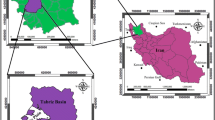Abstract
The idea of Groundwater Vulnerability is based on the supposition that the physical environment may shield groundwater to some extent from impacts from the environment and people, particularly concerning contaminants that reach the subsurface environment. The present study develops the aquifer vulnerability map of the Ranchi Municipal Corporation area through the GIS-based DRASTIC method by calculating Drastic Value Index (DVI) values. The greater the DVI value, the greater the potential for aquifer contamination. The DVI values are categorized into five classes from low to high. The study area has a varied range of Drastic Value Index (DVI) values. It has been found that 47.08% of the total research region comes under the moderately low vulnerability class, followed by the Moderate vulnerability class with 29.49% of the total research region, and 18.57% of the total area comes under the high vulnerability class. Hence, the DVI map could be helpful in the environmental risk assessment aspects during town planning or during the proposal for new developmental or industrial activities. It could also be useful in the site selection procedure for activities that could directly impact Groundwater, like landfill sites.
Access this chapter
Tax calculation will be finalised at checkout
Purchases are for personal use only
Similar content being viewed by others
References
Aller L (1985) DRASTIC: a standardized system for evaluating ground water pollution potential using hydrogeologic settings. In: Kerr RS (ed) Environmental research laboratory, office of research and development. US Environmental Protection Agency
Anshumala K, Shukla JP, Patel SS, Singh A (2021) Assessment of groundwater vulnerability zone in mandideep industrial area using DRASTIC model. J Geol Soc India 97(9):1080–1086
Baalousha HM (2011). Map** groundwater contamination risk using GIS and groundwater modelling. A case study from the Gaza Strip, Palestine. Arab J Geosci 4(3):483–494
Bai L, Wang Y, Meng F (2012) Application of DRASTIC and extension theory in the groundwater vulnerability evaluation. Water Environ J 26(3):381–391
Bera A, Mukhopadhyay BP, Das S (2022) Groundwater vulnerability and contamination risk map** of semi-arid Totko river basin, India using GIS-based DRASTIC model and AHP techniques. Chemosphere 307:135831
Connell LD, Van den Daele G (2003) A quantitative approach to aquifer vulnerability map**. J Hydrol 276(1–4):71–88
Daly D, Drew D (1999) Irish methodologies for karst aquifer protection. In: Hydrogeology and engineering geology of sinkholes and karst, pp 267–272
Evans BM, Myers WL (1990) A GIS-based approach to evaluating regional groundwater pollution potential with DRASTIC. J Soil Water Conserv 45(2):242–245
Foster S, Hirata R, Gomes D, D’Elia M, Paris M (2002) Groundwater quality protection: a guide for water utilities, municipal authorities, and environment agencies. World Bank, Washington, DC
Ghosh A, Tiwari AK, Das S (2015) A GIS based DRASTIC model for assessing groundwater vulnerability of Katri Watershed, Dhanbad, India. Modeling Earth Syst Environ 1(3):1–14
Karan SK, Samadder SR, Singh V (2018) Groundwater vulnerability assessment in degraded coal mining areas using the AHP–modified DRASTIC model. Land Degrad Dev 29(8):2351–2365
Mallik S, Bhowmik T, Mishra U, Paul N (2021) Local scale groundwater vulnerability assessment with an improved DRASTIC model. Nat Resour Res 30(3):2145–2160
McLay CDA, Dragten R, Sparling G, Selvarajah N (2001) Predicting groundwater nitrate concentrations in a region of mixed agricultural land use: a comparison of three approaches. Environ Pollut 115(2):191–204
Mitra D (2011) Coastal hazard and Risk analysis in the gulf of Cambay, India: using remote sensing data and GIS technique. VDM Publishing
Nair AM, Prasad KR, Srinivas R (2022) Groundwater vulnerability assessment of an urban coastal phreatic aquifer in India using GIS-based DRASTIC model. Groundw Sustain Dev 19:100810
Navulur KCS, Engel BA (1998) Groundwater vulnerability assessment to non-point source nitrate pollution on a regional scale using GIS. Trans ASAE 41(6):1671
Pande CB (2022) Land use/land cover and change detection map** in Rahuri watershed area (MS), India using the google earth engine and machine learning approach. Geocarto Int. https://doi.org/10.1080/10106049.2022.2086622
Pande CB, Moharir KN, Varade A (2023) Water conservation structure as an unconventional method for improving sustainable use of irrigation water for soybean crop under rainfed climate condition. In: Pande CB, Moharir KN, Singh SK, Pham QB, Elbeltagi A (eds) Climate Change Impacts on Natural Resources, Ecosystems and Agricultural Systems, pp 629–641. Springer Climate. Springer, Cham. https://doi.org/10.1007/978-3-031-19059-9_28
Pande CB, Patode RS, Moharir KN (2017) Morphometric analysis using remote sensing and GIS techniques (a case study of Devdari Watershed, Patur Tq., Akola District, Maharashtra). Trends Biosci 10(1): 219–223. ISSN 0974-8431.
Saranya T, Saravanan S (2021) Evolution of a hybrid approach for groundwater vulnerability assessment using hierarchical fuzzy-DRASTIC models in the Cuddalore Region, India. Environ Earth Sci 80(5):1–25
Singh R, Syed TH, Kumar S, Kumar M, Venkatesh AS (2017) Hydrogeochemical assessment of surface and groundwater resources of Korba coalfield, Central India: environmental implications. Arab J Geosci 10(14):1–16
Stempvoort DV, Ewert L, Wassenaar L (1993) Aquifer vulnerability index: a GIS-compatible method for groundwater vulnerability map**. Can Water Resourc J 18(1):25–37
Yu H, Wu Q, Zeng Y, Zheng L, Xu L, Liu S, Wang D (2022) Integrated variable weight model and improved DRASTIC model for groundwater vulnerability assessment in a shallow porous aquifer. J Hydrol 608:127538
Author information
Authors and Affiliations
Corresponding author
Editor information
Editors and Affiliations
Rights and permissions
Copyright information
© 2023 The Author(s), under exclusive license to Springer Nature Switzerland AG
About this chapter
Cite this chapter
Saw, S., Singh, P.K., Patel, R., Deoli, V., Kumar, D. (2023). A GIS-Based DRASTIC Approach for Aquifer Vulnerability Assessment: Study Conducted in the Municipal Corporation Region of Ranchi, Jharkhand. In: Pande, C.B., Kumar, M., Kushwaha, N.L. (eds) Surface and Groundwater Resources Development and Management in Semi-arid Region. Springer Hydrogeology. Springer, Cham. https://doi.org/10.1007/978-3-031-29394-8_3
Download citation
DOI: https://doi.org/10.1007/978-3-031-29394-8_3
Published:
Publisher Name: Springer, Cham
Print ISBN: 978-3-031-29393-1
Online ISBN: 978-3-031-29394-8
eBook Packages: Earth and Environmental ScienceEarth and Environmental Science (R0)




